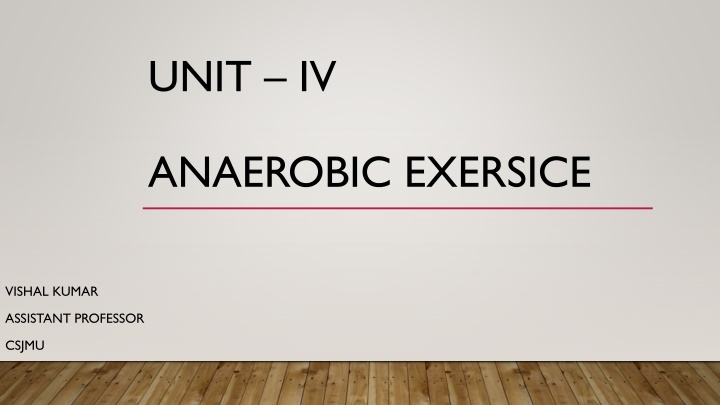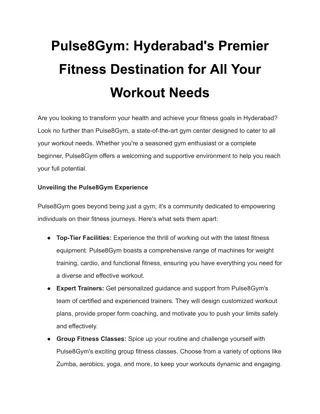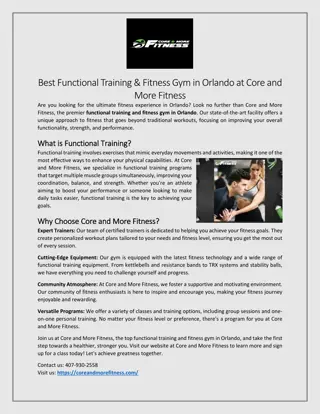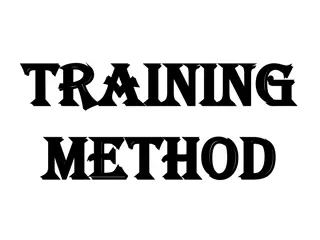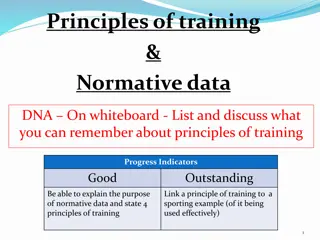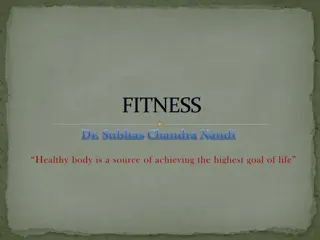Basic Principles of Resistance Training for Overall Fitness
Your overall fitness program includes various exercise types such as aerobic, flexibility, strength training, and balance exercises. Learn about weight selection, exercise techniques, spotting safety, body alignment, and proper lifting techniques to enhance your workout routine effectively.
Download Presentation

Please find below an Image/Link to download the presentation.
The content on the website is provided AS IS for your information and personal use only. It may not be sold, licensed, or shared on other websites without obtaining consent from the author.If you encounter any issues during the download, it is possible that the publisher has removed the file from their server.
You are allowed to download the files provided on this website for personal or commercial use, subject to the condition that they are used lawfully. All files are the property of their respective owners.
The content on the website is provided AS IS for your information and personal use only. It may not be sold, licensed, or shared on other websites without obtaining consent from the author.
E N D
Presentation Transcript
UNIT IV ANAEROBIC EXERSICE VISHAL KUMAR ASSISTANT PROFESSOR CSJMU
BASIC PRINCIPLES OF RESISTANCE TRAINING Program your overall fitness program is composed of various exercise types such as aerobic training, flexibility training, strength training and balance exercises. Weight different weights or other types of resistance, for example a 3 kg hand weight or fixed weight, body weight or rubber band will be used for different exercises during your strength training session. Exercise a particular movement, for example a calf-raise, that is designed to strengthen a particular muscle or group of muscles. Repetitions or reps refers to the number of times you continuously repeat each exercise in a set. Set is a group of repetitions performed without resting, for example, two sets of squats by 15 reps would mean you do 15 squats then rest muscles before doing another 15 squats. Rest you need to rest between sets. Rest periods vary depending on the intensity of exercise being undertaken. Variety switching around your workout routine, such as regularly introducing new exercises, challenges your muscles and forces them to adapt and strengthen. Progressive overload principle to continue to gain benefits, strength training activities need to be done to the point where it s hard for you to do another repetition. The aim is to use an appropriate weight or resistant force that will challenge you, while maintaining good technique. Also, regular adjustments to the training variables, such as frequency, duration, exercises for each muscle group, number of exercises for each muscle group, sets and repetitions, help to make sure you progress and improve. Recovery muscle needs time to repair and adapt after a workout. A good rule of thumb is to rest the muscle group for up to 48 hours before working the same muscle group again.
SAFETY TECHNIQUES SPOTTING - Spotting in weight or resistance training is the act of supporting another person during a particular exercise, with an emphasis on allowing the participant to lift or push more than they could normally do safely. Proper spotting for appropriate resistance training exercises enhances a lifter's mental and physical performance during resistance training. Without the use of spotting and subsequently proper spotting technique, weight-lifting participants put themselves at a higher risk for lifting-related injuries.
ROPER BODY ALIGNMENT Good posture helps the body to function effectively and will minimize muscle strain and injury. During exercise, whether you are sitting or standing, your body will potentially be in several different positions. If you add weights, such as dumbbells used for strength training, or increase your exercise intensity to a vigorous level remember to maintain proper form and posture. If you are lax on your posture or form you can easily sustain an injury and be sidelined. Take the time to learn proper body alignment and be mindful about how your body is feeling. Pain could be an indicator of incorrect form or posture. Keep your neck in line with your spine Keep your chin aligned with your neck, ears over shoulders Keep your back straight Keep your shoulders back, relaxed and down Keep your knees relaxed do not lock them Keep your pelvis slightly tucked under, belly button pulled back towards your spine
LIFTING TECNIQUE 1. Stand as close to the item as possible. This will prevent you from overstraining your back. Stand in front of the item with a wide base of support (feet at least shoulder width apart). 2. Bend your knees and keep your back upright, shoulders back, and head looking straight forward. There should be a natural curve in your lower back. This will help ensure you re using your legs rather than your back to lift the item. 3. Place both hands on the handles or sides of the item. 4. Avoid twisting your back. 5. Keep feet shoulder width apart to ensure a broad, stable base. 6. Keep the back straight (though not necessarily erect). 7. Keep the arms close to trunk. 8. Keep the load / weight close to the Centre of gravity and within the Base of support. 9. Lift using the strong muscles in the legs, rather than the postural muscles in the trunk. 10.If the load is too heavy for one person, wait until you can get help.
SPATIAL AWARENESS Spatial awareness refers to your ability to be aware of objects in space and your body s position in relation to them. Soccer, baseball, gymnastics, and dance are all great choices (and even better, these activities keep kids active and healthy). Not only will he have a ball, but things like adjusting his bat to the different positions of a pitched baseball, learning that standing too close on the dance floor means a run-in with someone, or discovering just how hard to kick the soccer ball to make a goal will help him gain valuable spatial=-awareness skills.
BREATHING TECNIQUE Before you begin your work out, practice breathing. Make sure you are engaging your diaphragm, ensuring your body continues to get the most oxygenated air. Take a deep breath in on theeccentric portion of your lift. For the bench press, this would be when you lower the weight to the chest. For dumbbell curls, it is when you lower the dumbbell down to its original position. Exhale during the concentric phase of the lift. For the bench press, this will be when you explode upward. For dumbbell curls, it is when you lift the dumbbell to your shoulder. Avoid the Valsalva maneuver during regular sets. The basic breathing technique for lifters should be to take a deep breath in as they lower the weight and exhale as they lift the weight or work against gravity. You will be able to properly circulate oxygen throughout your body to your muscles and protect you from harm.
PRINCIPAL OF WEIGHT TRANING Compound exercise: A movement where more than one joint is used. For example, a squat is a compound movement, as the hips, knees and ankles are all involved. Isolation exercise: A movement where only one joint is used. For example, a bicep curl is an isolation movement, as the elbow is the only joint involved. Supinated grip: A grip position where the lower arm is rotated so that the palm is facing upwards. Pronated grip: The opposite of supination, so the palms will be facing down. Superset: Performing two different exercises in each set with no rest in between. This keeps your heart rate elevated, involves more muscle fibres and burns a lot more calories! Drop set: When you reach the point of failure, pick up lighter weights and continue the set until you reach failure again. Pyramid set: With each set, you increase the weight and lower the reps. Workout split: Splitting the muscle groups between different days of the week. For example, Monday might be hamstring and glute day, Tuesday is for arms, and so on. Eccentric contraction: Lengthening of the muscle, also known as the negative portion of a lift. For example, the controlled downward movement in a bicep curl. Concentric contraction: Shortening of the muscle, also known as the positive portion of a lift. For example, the upward movement in a bicep curl.
Overload Progression Focus on the breath The mind-muscle connection Rest and recovery Specificity Leave your ego at the door
CONCEPT Weight training Exercises which use the weight of an object to provide resistance to movement. - It is recommended to weight train 2-3 non-consecutive days a week.
Why weight train? a. Improve health and overall fitness. The body contains about 600 muscles. Muscles make up about 50% of your body weight (40% are skeletal muscles and 10% are involuntary muscles of the circulatory & digestive system) All human movement is the result of muscle contraction Weight training increases the amount of muscle tissue in the body. About 75 calories per day are used to support the energy needs of 1 lb. of muscle tissue. About 3 calories per day are used to support the energy needs of 1 lb. of fat tissue. Since muscle tissue is active tissue that consumes calories and fat is inactive tissue that stores calories, those who are trying to lose body fat should increase their muscle mass to burn more calories b. Improve appearance (tones and defines muscles) c. Improves movement performance (increases skills) d. Improves muscle strength, endurance, & power strength - how much weight can be lifted endurance how much weight can be lifted repetitiously over an extended period of time power how much weight can be lifted within a specified time period o power is needed for rapid, explosive movements
Safety guidelines: a. Warm up (jog or walk around gym) and stretch before lifting, cool down after lifting. b. Perform all lifts using strict exercise form. Smooth,'controlled'movements,'don t'jerk'or'wobble,'don t' bounce'weights'off'your'body c. Perform all exercises with a full range-of-motion. Unless'trying'to'develop'strength'or'power'in'a'particular'portion' of'the'range=of=motion d. Keep knees bent, back straight when lifting & setting weights down e. Do not arch back/neck or twist body when performing a lift. f. Do not hold your breath and strain when lifting a weight, breath regularly and naturally. Exhale'on'exertion g. Lift within your ability (not more than you can safely handle), use a spotter for bench press lifts. h. Move carefully in the weight room, be aware of others, & do not fool around. i. Check all equipment make sure it s stable, always balance weights on a barbell, make sure collars are secure, and make sure pins are firmly in position. j. Store and return all equipment to its proper place when you are finished. k. Wear proper clothing. Loose'clothing'is'good,'but'baggy'clothes'could'catch'in'the' machines
Myths!about!weight!training: a. Weight'training'causes'huge'out'of'proportion'muscles'==='only'if'you'train'for'that'look. b. Weight'training'makes'a'woman'look'masculine. Men'have'6=10'times'more'of'the'hormone'testosterone,'which'contributes'to'the'second ary'characteristics'considered'masculine. o Women'who'weight'train,'generally,'develop'healthy,'shapely,'trim'female'figures. c. Weight'training'makes'you' muscle'bound '(inflexible,'limited'range=of=motion)' Not'if'you'train'each'muscle'through'its'full'range=of=motion'(full'extension'to'full'contract ion),'one'will'actually'be'more'flexible.
